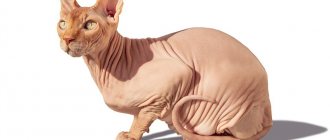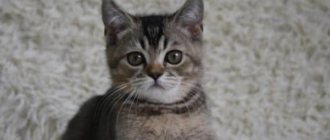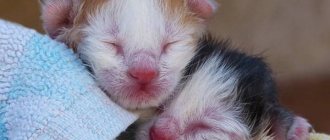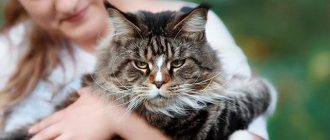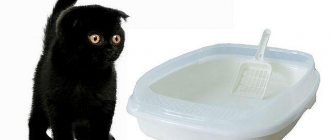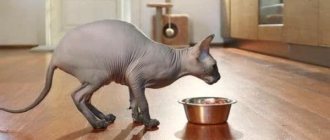10825Administration
At 3 months old, a Scottish Fold kitten is quite independent and adapts perfectly to a new place of residence. Therefore, it is at this age that it is recommended to buy a small pet and accustom it to a new home. The nutrition of such a kitten, as a rule, has already been established by the breeders and the new owners will not have any problems in selecting food or preparing a diet.
There will also be no problems in teaching your baby to use the toilet, his own place; At this age, the main character traits are clearly visible, thanks to which you can choose the one who will fully meet your expectations. Choosing a Briton with an easy-going character will always be a pleasure . Before choosing a three-month-old Scottish kitten, it is worth studying several sections of information:
- at what interval and what to feed him;
- when is it necessary to vaccinate and what kind of vaccinations are needed;
- what conditions are necessary for a comfortable location;
- how much does a Scottish kitten weigh at 3 months and what should it look like.
© shutterstock
What to feed a Scottish kitten at 3 months
At 3 months old, a Scottish Fold kitten is quite independent and adapts perfectly to a new place of residence.
Therefore, it is at this age that it is recommended to buy a small pet and accustom it to a new home. The nutrition of such a kitten, as a rule, has already been established by the breeders and the new owners will not have any problems in selecting food or preparing a diet. There will also be no problems in teaching your baby to use the toilet, his own place; At this age, the main character traits are clearly visible, thanks to which you can choose the one who will fully meet your expectations. Choosing a Briton with an easy-going character will always be a pleasure . Before choosing a three-month-old Scottish kitten, it is worth studying several sections of information:
- at what interval and what to feed him;
- when is it necessary to vaccinate and what kind of vaccinations are needed;
- what conditions are necessary for a comfortable location;
- how much does a Scottish kitten weigh at 3 months and what should it look like.
How and where to buy a kitten?
Straight-eared and fold-eared Scots are sold in nurseries for 3 months, if you look at their websites in the “Kittens for sale” sections. Also at this age, you can purchase a kitten from uncertified breeders who post their advertisements on the Internet on ad sites, although this is a black market - it is more expensive to use its services. It is not always easy to find three-month-old kittens in nurseries, even if they are physically there. The point is that they are booked in advance. But if you search in different nurseries and not only in your city, you will definitely find several kittens. Or you can find kittens 1-2 months old and book them in advance.
If you are interested in how Scottish kittens grow up, go to the flash mob page “It Was and It Was.”
Source
Nutritional rules for a Scot at 3 months
The most common first question that arises for owners of a Scottish kitten at 3 months is: what to feed a Scottish kitten at 3 months?
After all, at this age he can chew even solid food on his own, but at the same time, without knowing the basic rules of nutrition, it can lead to indigestion in a Scottish kitten at 3 months and completely disable the digestive tract, which is unacceptable for such small kittens.
To prevent this from happening, several rules must be taken into account:
- Under no circumstances should you give raw fish, and it is better to refrain from feeding fish, with the exception of sea fish;
- meat can only be given fresh frozen or well-cooked, after it has been cooked and removed from all cartilage and bones;
- It is recommended to introduce porridge and various types of cereals into the diet, mixing them with meat and offal;
- If you include offal in your diet, you need to wash and boil them well in order to eliminate the presence of parasites and blood.
How to care for a three month old cat
Caring for a three-month-old kitten consists, first of all, of proper nutrition. You can read more about it in the article “ What to feed a Scottish kitten . ”
You can also bathe him now. It’s not so easy to do this the first time; on the other hand, you need to get used to it now, because... As an adult, the cat will already get used to this procedure if you start small.
A very important point is vaccinations. If they were not made by a breeder, you will have to arrange them. To do this, bring your cat to the veterinarian for the first time: let him do an initial examination and give him an anthelmintic. In 2-3 weeks it will be possible to give the first vaccination. The veterinarian does this too. After a while - the second. Before vaccinations, the cat must be completely healthy.
Also at this age, you can conduct a course of vitamins and minerals for kittens with a high calcium content. At this time, the musculoskeletal system is actively developing in cats, which really needs calcium. You can also support your developing heart with taurine supplements.
Caring for a three-month-old Scottish kitten should include not only caring for the body and adjusting behavior, but also a psychological factor. The child still needs a mother, and your task is to replace her. Be gentle and speak in a soft voice. And play: in the game the kitten learns to trust you. Only your games should not be aggressive. Otherwise, you will be constantly scratched, and the kitten will be nervous. Don't let it attack your hands: you can only play with objects. Buy a special mahalla and balls for this.
Scots diet at 3 months
The diet of a three-month-old Fold kitten also includes a small amount of fermented milk products and milk, but their fat content should be strictly limited, since the presence of very fatty foods can lead to intestinal upset . Proper feeding of a kitten at the age of 3 months should begin 4 times a day, and it is necessary to constantly ensure the availability of fresh, boiled water.
At any age, Scottish cats love to enjoy tasty additives to their main diet, but they should not be abused; vitamins and additional supplements should be given only after consultation with a veterinarian.
Following all these recommendations will allow you to provide a balanced diet and adjust the diet of a British breed cat in order to ensure good coat quality, growth and activity.
Scot's personal schedule
If you decide to adhere to the regimen suggested by the breeder and organize feeding a four-month-old kitten with special food, then you should not skimp on it and choose food for adult animals. After all, the difference lies not only in the size of the food, but also in its balance, saturation with vitamins and microelements, which are so necessary for the healthy growth of the animal and the formation of the correct skeleton and joints.
With the permission of the veterinarian, you can add special dietary supplements and treats. Proper nutrition for a 4-month-old kitten should be based not only on the correct choice of products, but also on compliance with portions and diet.
The baby should weigh no more than the norm provided in the special table for Scottish kittens of 4 months. The serving size is determined not based on your baby’s appetite, but on the dosage provided on the packaging of special foods or nutritional recommendations.
Required vaccinations for Scots at 3 months
After you have adopted your little cat from the cattery, one of the main questions that arises is the need for vaccination. A three-month-old Scottish kitten should only be vaccinated by a veterinarian.
Considering that vaccination is carried out within a period of 8 to 12 weeks , special attention should be paid to ensuring that the doctor correctly enters the vaccination data into the veterinary passport. After all, regardless of whether the cat takes part in competitions and exhibitions or not, it must be vaccinated annually.
It is also of great importance whether the mother of the Scottish kitten was vaccinated at 3 months, since if vaccination was not given, vaccination must be given from 8 weeks, and if the mother has a veterinary passport and all necessary vaccinations have been carried out, she can be taken to a veterinarian at the age of 12 weeks.
If for some reason you missed the deadline for vaccinations, then every veterinarian will recommend not to carry out any medical manipulations with the Scottish cat from 4 to 7 months, since during this period his teeth change. Immediately before the injection, the doctor will definitely examine your pet, since the presence of any diseases is a strict contraindication . In addition, do not forget about mandatory digilmintalization before vaccination.
Features of three months of age
As we have already said, at 3 months kittens are completely independent. They already know the litter tray and scratching post if the breeders have taught them to use them. They can still go to the tray with mistakes, but these are isolated cases.
Such kittens already accept adult food, but if they stay with their mother, they can sometimes suck milk. They readily eat whole pieces of meat as complementary foods and can even gnaw on a chicken head if they have been accustomed to this since 2 months. At the same time, many owners prefer to keep their animals on industrial food. In this case, the food should be at least super-premium class.
The only problem that a three-month-old kitten may have if it has just been torn away from its mother is the quality of its licking. In childhood, all kittens learn this from their mother cat, but they begin to wash themselves really well, not for imitation, but for the good of the cause, when they are left alone. In the first couple of weeks after moving to a new home, the kitten may not lick itself very well, and in the butt area it generally has to be helped, but then its toilet becomes more thorough. If he stubbornly ignores the genitals and anus, you can anoint his butt with fish oil or vegetable oil: cats begin to lick themselves when they smell a foreign smell. In addition, they like the taste of oil, so it will be good to lick it.
As for behavior, at 3 months he is still a small kitten. He will run around the house, meow, flirt with you, and possibly ambush you. This is normal behavior for him, but I would like to warn you: try to correct the kitten’s behavior now, because later it will be more difficult. If, for example, you don’t like him attacking his legs, forbid it. By the way, it’s better to do this even if you like it, because it can simply be dangerous for the baby. One day, a reader contacted the editors of our site and told the story that her kitten died under her husband’s feet, suddenly jumping under them while he was walking. It is also worth accustoming the kitten to a general culture of behavior: do not sharpen its claws anywhere, do not bite flowers, etc.
Weight and appearance of a Scottish kitten at 3 months
At 3 months old, a Scottish kitten looks quite strong and tall, and the features of its physique are already clearly visible. At this age, you can easily understand what an adult cat will look like; you can clearly see the color of the coat, and sometimes the color of the eyes. The weight of a 3-month-old Scottish kitten can vary from 900 to 1600 grams.
Before taking your baby from the nursery, you need to get his veterinary passport and find out exactly:
- how much does a Scottish kitten weigh at 3 months;
- what diet was followed;
- whether all necessary vaccinations have been completed;
- what features were there in the organization of his life;
- what kind of litter was used for the toilet.
All this is very important in order to ensure a smooth adaptation to the new home and minimal trauma to the baby’s psyche.
Natural food
The option is not the simplest, and also requires some costs. To create a natural menu in accordance with the requirements of the Scottish cat, you will have to come up with several healthy recipes.
Food from the table is harmful to the cat!
Let's look at what foods you should give your cat:
- Meat. It must be either frozen or heat-treated. Regular raw meat should not be given to cats. Of the varieties, preference should be given to low-fat varieties, for example, beef.
- Bird. The best option would be chicken meat. It must be boiled before use.
- By-products, such as liver. You should treat your pet with it no more than once a week. Be sure to boil before serving.
- Fish. Only marine and low-fat. The ubiquitous myth that any fish is good for cats is high time to debunk. River fish is dangerous for cats' health! Therefore, you can treat your cat to seafood no more than once a week.
- Dairy products. Offer your Scottish cat cheese, sour cream or kefir several times a week. It is unlikely that your pet will refuse such a tasty treat.
- Eggs, namely boiled chicken yolk.
- Milk and milk porridges are beneficial for young animals. They are necessary in the diet only until the age of 6 months. After this period, dairy products can cause distress in the cat.
- Cereals. Optimal source of slow carbohydrates. The cat gets energy from them, so it is necessary to treat your pet with rice, buckwheat and oatmeal. If the cat thinks otherwise, convince him otherwise by mixing porridge with meat.
- Vegetables. Source of vitamins. Most likely, boiled carrots will also have to be mixed with meat, but it’s worth it. After all, the health of your pet depends on the presence of vitamins.
Someone's hungry
Cats are carnivores by nature, so the main ingredient in a Scottish cat's diet should be meat. Protein is essential for muscle building, visual acuity and reproductive function.
Remember about product compatibility
When feeding Scottish and other breeds, it is important not to mix incompatible foods: dairy treats should be a separate meal. The same goes for vegetables.
What cats can't do
When creating a diet, it is important not only to provide your cat with healthy foods, but also to protect them from harmful ones. Cats should not be given:
- Food from the table. You cannot treat cats to food with seasonings, as well as salty, smoked and sweet foods;
- Fatty meat is prohibited not only for Scots, but also for other breeds;
- Baked goods, baked goods and sweets.
I want to, but I can’t
Vitamins
Even the highest quality natural food is not able to provide a cat’s body with the necessary vitamins. To give your pet a burst of strength, buy a vitamin and mineral complex for cats at a veterinary pharmacy.
The tablets are usually “equipped” with a pleasant smell, so giving the pill to your cat will not be difficult.
In some pharmacies you can find special complexes for the Scottish breed. The composition of such tablets takes into account the breed’s love of hunting and meat products, and also adds the required amount of plant elements.
It wouldn’t hurt to grow a pot of “cat” grass on the windowsill. Seeds of such a delicacy can be bought at the same pet store. The sprouts will hatch in just a few days, and the cat will have the opportunity to eat a fresh, vitamin-rich salad.
Personal lawn
In addition to food, the cat should have drinking water in a separate bowl. The drink needs to be changed daily. Some pets prefer to drink tap water, which does not cause any harm.
You cannot bring grass from the street for your cat! The stems of outdoor plants may contain parasite larvae that can infect your pet.
Examples of natural dishes
To avoid wondering what to cook for your Scottish cat for lunch, use one of the tips below:
- Pour boiling water over fresh beef (75 grams) and add 20 grams to it. lungs. Mix all this with oatmeal steamed in boiling water. Add half a teaspoon of vegetable oil and dry yeast (on the tip of a knife) to the finished porridge.
- Mix boiled buckwheat with chopped liver. Add lean, boneless fish. If necessary, add a small amount of water and grind the mixture using a blender.
note
You should not focus solely on the baby’s appearance when meeting you; you must take into account the habits, character traits and sociability of a particular Scottish kitten at 3 months.
At this age, he should clearly know where the tray is, easily make contact, respond with purrs to various caresses and strokes, and also have a healthy appetite.
If the baby shows aggression, it is necessary to pay attention to the conditions of his detention in order to determine whether this is an innate character trait, or whether it is simply the presence of irritating factors, such as: too small an area for habitat, a large number of small kittens, insufficient care. If you carefully choose your new pet, he will delight you for many years or months and will become an excellent friend in a cozy home.
Sample menu by age
A sample menu by age will help you assess your ability to care for your future pet. The recommendations below are not clear instructions; always rely on the rate of development, growth and weight gain of your pet.
Important! To adequately assess the diet, weigh the kitten regularly. Sudden changes in weight will tell you how and when to adjust the menu.
Menu for a kitten up to a month
Up to a month, kittens feed only on mother's milk. If the baby is orphaned, he needs to be artificially fed.
Distinctive features
This breed is distinguished by its striking manifestation of sexual dimorphism: males are larger and stockier than females, cats are more graceful and elegant.
- almost perfectly round head on a short neck;
- elegant body;
- well developed outstretched paws;
- long straight tail.
The main feature that distinguishes them from the British is their miniature ears, triangular in shape. Because of the crease, they seem to be bent down and pressed against the skull.
International associations allow all colors - from white to tortoiseshell, but there are exceptions: lavender, chocolate and colorpoint.
How old do Scottish cats grow?
As for how Scottish kittens are born, it depends not only on the genetics of the parents, but also on the number of kittens in the litter: the more there are, the less weight each will have. However, kittens born with different weights can eventually level off with age: every day they will gain 10-20 grams until 1 month, and at the age of 1 to 6 months - up to 100 grams per day.
Kittens require a balanced diet to grow. Calcium is important for the formation of the skeletal system, but calcium without phosphorus leads to an excess, which is fraught with negative consequences. In addition, calcium cannot be absorbed without vitamin D. Therefore, all microelements supplied through food must be in harmony. A very small kitten receives everything it needs from its mother through milk for 1 month and, if the mother eats a balanced diet, the kittens grow stronger. And if the mother does not receive enough microelements, the children can get, for example, hyperparathyroidism. Read about how to feed kittens weaned from their mother's breast here.
As can be seen from our table, Scottish kittens grow intensively until about 8 months, then growth slows down, but changes are still noticeable until 1 year. Further, from 1 year to 2 years, the Scottish cat still grows a little, but this is not significant: during this time, the maximum she can gain is about 0.5-0.7 kg, unless, of course, some nutritional disruptions occur and the cat , for example, does not become obese.
With cats, these numbers shift: intensive growth occurs up to 1 year, and then a Scottish cat can grow up to 2.5 years, but this is no longer significant.
Starting from 4 months, your pet is already a teenager. Theoretically, if a cat lived outside and went into heat, adult cats would perceive her as a sexually mature female and could come into contact with her. Similarly, other cats could fight with a large six-month-old male, perceiving him as an equal.
At six months, a teenage kitten has already gained 70% of its body weight, so in the future it should, at most, gain the missing 30%.
MisterCat warns: advantages and disadvantages
The breed has various advantages and disadvantages.
| pros | Minuses |
| Sweet beautiful face. | Greed. |
| Friendliness. | Indiscriminate eating. |
| High intelligence. | Prohibition on mixing with fold-eared and British cats. |
| Wide range of colors. | Selfishness. |
| Good health and long life. | Stubborn character. |
| Love for cleanliness. | Fear of moving. |
Temperament
The Scots are moderately active, preferring sleep to aimless running around. This does not prevent them from being playful and active when necessary. They love various games with toys, and with proper training they quickly learn commands.
Dependent on human attention. They quickly become attached to the family. They don’t choose a “favorite” - they love every family member equally. They cannot stand being alone for long periods of time, so people without a family and with a job that requires constant absence should not get a pet.
This does not mean that the pet is annoyingly intrusive; on the contrary, their high level of intelligence helps them understand when they are in the way. They are not loud, their voice is quiet and pleasant.
The only thing that throws a Scottish cat out of balance is moving or a new place. In this case, the owner should be nearby and help him adapt correctly.
Sociable pets react calmly to small children and other pets.
Features of care and maintenance
The unpretentiousness of Scottish Folds is one of the main criteria when choosing individuals of this breed as pets. They are easy to care for; your pet's ears and eyes deserve special attention.
Ear and eye care
Due to the unusual structure of the ears, Scottish Folds cannot keep them clean on their own. Their ears should be inspected regularly; cleaning once every three weeks is sufficient, using a cotton swab or a disc without a seam around the edges. It would be useful to use special lotions Ear cleaner, Otifree or similar, as well as Rescuer and Guardian balms. During the cleaning process, you should use a stick in the direction from the base to the tip of the ear. There is no need to penetrate deep inside to avoid injury.
Be careful when cleaning your ears
Scottish Folds have a brachycephalic muzzle, which is why their nasolacrimal ducts are narrower than those of other cats. This can cause your pet's eyes to water frequently. This is completely normal, of course, if the discharge is not excessive and transparent. Eye care involves promptly blotting the discharge with a soft, lint-free cloth or dry cloth. There is no need to rinse them with water - this will lead to disruption of the microflora and subsequent inflammation.
Grooming and bathing
It is enough to brush short-haired “Scots” once a week, and every other day during the shedding period. For this procedure, you should alternately use a comb with sparse, long teeth and a fine brush made of natural bristles or a massage brush with an antistatic coating. If the tail looks good, then it is not recommended to touch it. At the end of the combing process, you should walk through the fur with wet hands to collect the combed hairs.
“Scots” should be bathed as rarely as possible, because this procedure is stressful for the animal and the person. In addition, frequent washing worsens the protective properties of the cat's skin. Instead of taking a bath, you can use dry shampoo or bran heated in the oven. A special product or bran should be rubbed into the pet’s fur and then combed out with a fine brush.
Tooth and nail care
To clean your Scottish Fold's teeth, you can use special dry food and chewing toys. Once a week it is recommended to use a special paste and brush. Regular examination by a specialist will help prevent the formation of tartar.
If your cat gets its long claws caught on carpet or clothing, it can get injured. In addition, during the game she may accidentally injure her partner. A nail clipper should be used to trim claws. The procedure has its own nuances - you only need to cut off the transparent part of the claw, without affecting the pink area where the blood vessels are located. An animal needs to have a “manicure” once every 14 days up to six months of age and once every thirty days for adults.
You need to trim your cat's claws carefully, without touching the sensitive pink area.
Nutrition
The diet of Scottish cats must be balanced and consist of high-quality products. By using ready-made premium food to feed your animal, you can be sure that your pet gets everything it needs. Those owners who choose natural products for their cats should know about the principles of proper nutrition:
- The basis of the diet of “Scots”, however, like all cats, should be meat - boiled or raw, but frozen. It should be boneless and lean - poultry or beef will do.
- A portion of meat food for “Scots” is usually enriched with plant foods - cabbage, carrots, pumpkin, parsley or bran.
- Pre-boiled offal is also used to feed Scottish Folds. Pets should be given fish no more than once a week - only sea fish, boned and boiled.
- The diet should also include low-fat fermented milk products and porridges - buckwheat, rice, oatmeal.
- Experts recommend including calcium or seaweed supplements in the Scots’ diet.
- The animal also needs to eat grass - it contains useful elements and helps remove lumps of fur from the stomach that form when cats lick their fur.
The feeding frequency of individuals up to one and a half years old is from 3 to 5 times a day. Older animals can be fed no more than 3 times a day. Your pet should always have water in his bowl.
You can feed Scottish cats either natural food or ready-made premium store-bought food.
Nutrition
The main disadvantage of the breed is greed and indiscriminate eating, which leads to serious illnesses. Experienced breeders advise creating a diet.
Before purchasing, find out how feeding went in the first house. The transition from the old regime should be smooth so that the baby’s fragile body is not damaged.
The first additions are soft canned or bagged food. After the fourth month, premium dry food is added, which contains enough protein, vitamins and essential taurine.
The main thing is to avoid excess calcium in the kittens’ diet so that their ears don’t stand up.
As a reward or just a treat, occasionally give meat or fish and vegetables.
- homemade food;
- sausages;
- sweets;
- bird bones.
Prohibited Products
It is important to exclude prohibited foods from your Scots kitten’s diet:
- Bones, pure fat, skin, especially poultry.
- Palm oil.
- Grapes, raisins.
- Juicy and sweet fruits.
- Soy.
- Mushrooms.
- Corn and semolina.
- Raw freshwater fish.
- Dry, salted fish.
- Products containing sugar or sugar substitutes.
- Products containing xylitol (chewing gum, some sweets).
- Products containing flour or yeast.
- Products containing caffeine, cocoa, any stimulants (sweets, tea, coffee, chocolate)
- Products containing marinades, salt, spices.
- Smoked products, including sausages, balyk, fish.
- Expired products.
- Leftovers from the table.
Controversial foods in the diet are:
- Fresh pork is a source of helminths and false rabies.
- Raw ocean fish are a source of helminths.
- Whole milk – risk of individual intolerance.
- Chicken eggs are an allergen.
- Factory-bred chicken – risk of allergies and individual intolerances.
- •Raw and boiled chicken liver in large quantities.
- Cereals.
Controversial products can be given to a kitten if an allergic or other acute reaction does not occur after taking them.
Upbringing
From the first days, it is important to teach your baby a routine in the house, communicate with him, and show him who is in charge in the house. An ill-mannered and uncommunicative creature will bring many problems in the future. Smart pets are prone to manipulation and whims if they do not see authority in a person.
Before buying, you need to come up with a name and say it more often so that he gets used to it faster.
You should not resort to physical punishment; the best method of education is a decisive “no” and patience. The most important thing is to show that the cat should not climb onto tables, beds and all forbidden places in the house.
Aggression and whims are condemned. Damage to things must not be allowed.
Scottish Folds are not picky and do not require any maintenance skills.
Eyes
Month-old kittens are prone to eye infections. First of all, you need to show them to the doctor. Standard treatment is to periodically wipe with a cotton swab soaked in chamomile infusion or medicine.
The weak point of all such cats. Cleaning is carried out at least once a week. It is better to replace cotton swabs with tampons with a special liquid. It is important to be careful so that your little pet gets used to the procedure and does not experience fear.
A typical disease - ear mites - manifests itself in the appearance of a brown crust in the ear. At the first symptoms, you need to see a veterinarian as soon as possible.
Wool
The fur does not require special care. During shedding, it is enough to brush no more than once a week. Increased attention is paid to a pet that walks along the street in the spring-autumn period - there is a high probability of acquiring a company of ticks.
Choosing a place and dishes
Set up a place for eating, buy 2-3 bowls for food and water. It is best for a Scottish Straight kitten to use bowls that are not too deep, but wide.
While eating, the kitten's whiskers should not come into contact with the sides of the dishes. For water, the bowl should be deeper. It is placed away from food bowls.
For feeding, buy bowls from:
- high-quality plastic;
- ceramics;
- clay;
- stainless steel
Kitten bowls should be stable and not make noise when the kitten eats. We do not recommend using aluminum cookware, as aluminum releases harmful chemical compounds upon contact with warm food.
If there are other animals in the house, the bowls are placed on a raised platform (bedside table, window sill). The kitten should not feel stressed while eating.
The choice of place and dishes depend on the age, individual, breed characteristics of your pet, as well as on the conditions of its maintenance and your financial capabilities.
What to feed a Scottish kitten depending on age
For the first 2 months, Scottish kittens feed on the milk of their mother cat. Despite this, they begin to be fed long before they are weaned off their mother's milk.
Like all carnivores, the diet should include food high in animal protein. For the normal growth and development of Scots, it is important not only to choose the right food, but also to feed them strictly on a schedule.
At home, it is recommended to use 3 types of feeding:
- natural products;
- industrial feed;
- mixed products.
A mandatory requirement is that the food in their bowl must always be fresh.
First month
A mother cat does not always have enough milk to feed her offspring. In such cases, babies are saved from starvation with formula milk.
Until Scottish kittens reach the age of two weeks, it is given to Scottish kittens every 2–2.5 hours. At 3–4 weeks, the interval between feedings with formula is increased to three hours.
All complementary foods for kittens under 1 month of age should be soft. You can feed a Scottish fold and straight-eared kitten during this period:
- cereals boiled in water and diluted with milk;
- boiled, ground and diluted chicken with bottled water;
- grated boiled vegetables.
This food is suitable for daily consumption. Once or twice a week you can give kefir, fermented baked milk or curds. The bowl should always be filled with clean bottled water. It needs to be changed at least once a day.
At this age, Scottish Folds eat at least 8 times a day. The food intended for them should be at room temperature.
From a month to six months
Caring for a Scottish Fold or straight-eared kitten changes from the second month of life: by this time the animal’s first teeth appear.
- The rapidly growing organism of Scots requires high-calorie food, so kittens at this age begin to be fed egg yolks mixed with minced meat. Stop cooking the vegetables, grate them on a fine grater or chop them raw in a blender.
- Including mother's milk, the total volume of food consumed by the kitten should not be less than 120 grams per day. From the age of two months, animals begin to be accustomed to industrial feed. It is important to monitor their quality and choose according to the age of the animals. Dry food is soaked in water or milk.
- At 3 months, Scottish kittens are completely transferred to food food and weaned from their mother's milk. At this age, breeders begin to give away babies. Once in the hands of a new owner, animals should not feel a sudden change in the composition of their diet. This can disrupt their digestive system. The result is vomiting and diarrhea.
- Feeding becomes 6 times a day. The daily volume of food consumed does not exceed 180 grams. Dry food for Scottish fold and straight-eared kittens is no longer soaked. By 3 months, animals have fully formed dentition. Boiled meat is no longer ground, but cut into small pieces.
- To replenish the body of Scots with the necessary vitamins, meat is mixed with pureed raw vegetables. Bran is added to this mixture. Along with vegetables and meat, the diet includes porridge cooked in water.
- At the age of 4-5 months, Scottish kittens should eat approximately 240 grams of food per day. They eat 4-5 times a day. The diet is not fundamentally changed, but the proportion of products in it is changed. The food for six-month-old Scottish fold kittens contains more poultry, rabbit and beef. Their pieces do not need to be finely chopped. Large cuts of meat promote animal jaw development.
- The amount of meat in the diet should be at least 160 grams per day. Porridge cooked in water is enriched with pieces of raw vegetables, minerals and vitamins, which are added to the product in the form of a mineral complex purchased at a veterinary pharmacy. Straight-eared and fold-eared kittens transferred to commercial nutrition should receive only age-appropriate food from one manufacturer. From the 5th month of life, Scots begin to be given sea fish.
Description of Scottish folds
Adult Scottish Fold cats are medium in size, with adult males being larger than female cats. The body is slightly elongated and this differs from the stocky type of British cats. The animals' shoulders and hips are the same width. The chest stands out for its volume and considerable width for cats of this size. True Scottish Folds never look fat or clumsy. Their movements are always graceful and easy. The length of the limbs ranges from medium to long. But the paws themselves are noticeably round and graceful.
Tail
medium length, it should be proportional to the body.
The tail begins with an expanded base and ends with a blunt tip. Sometimes Scottish Fold kittens have thick and fluffy tails. This feature is accompanied by thickened hind limbs, which affects the gait of the animal. At the dawn of the breed, these signs were considered positive. However, over time, such cats were no longer allowed into exhibitions. Animals with a flexible, movable tail are especially valued in the Scottish breed. This requirement is dictated by the fact that Scottish Fold cats often have joint problems.


